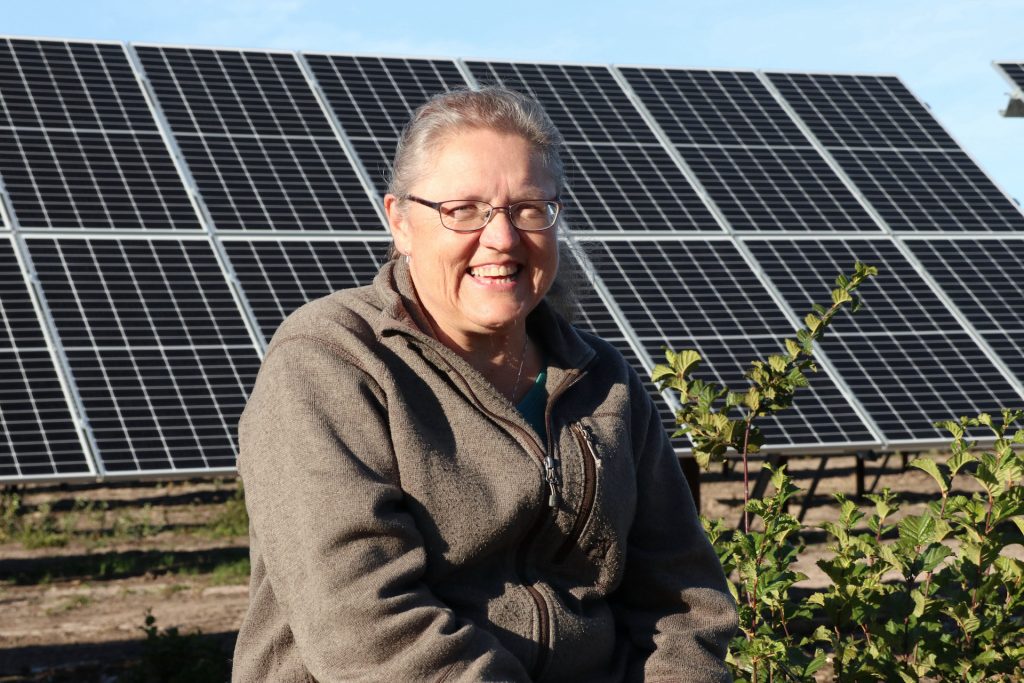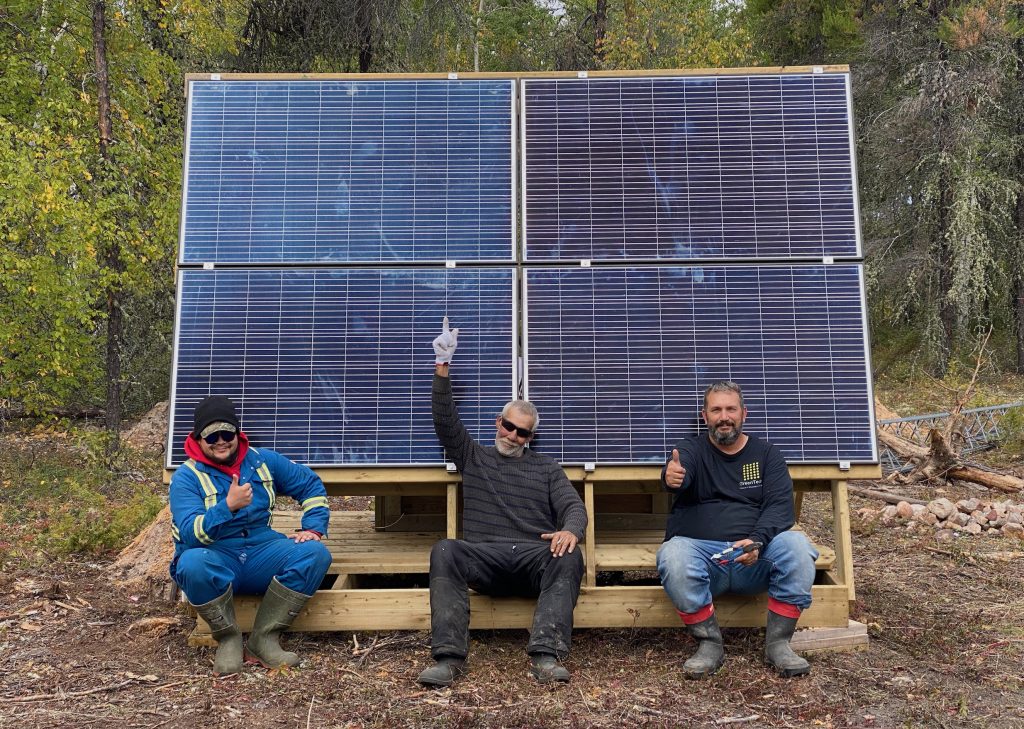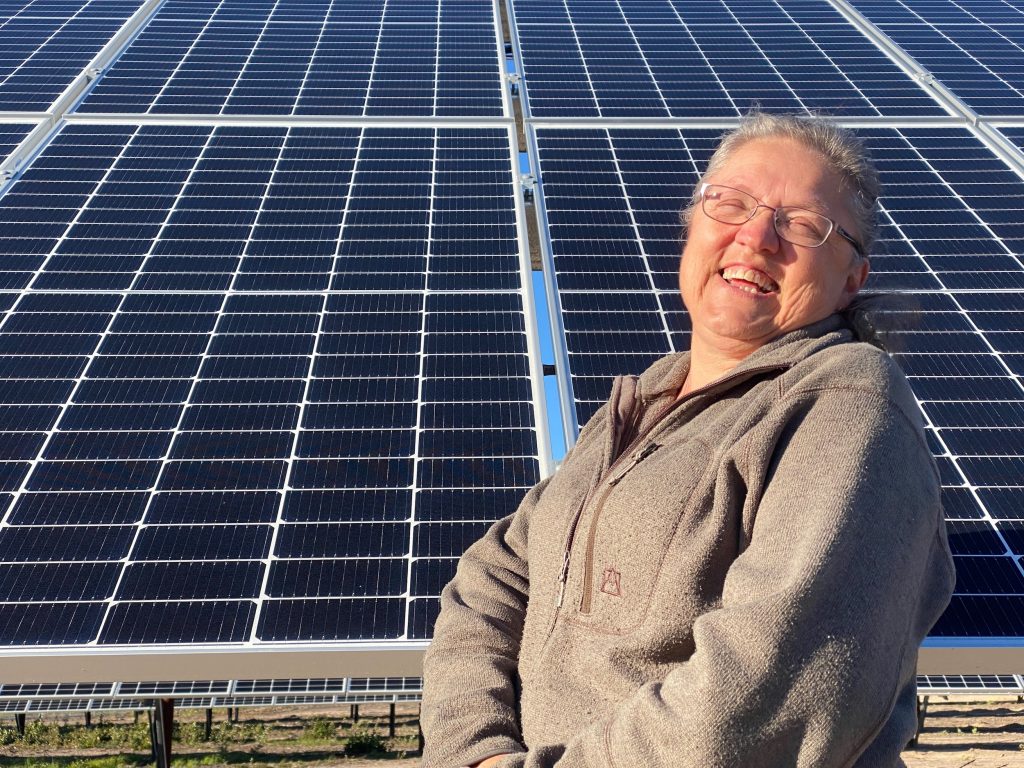By David Dodge and Kay Rollans
Many of the people from the three Indigenous Nations in Fort Chipewyan, Alberta—a community of about 1,000 residents—have cabins out in the wilds of the Peace-Athabasca Delta. Blue Eyes Simpson is one of them.
The cabins are invaluable to their owners, who use them for hunting, fishing, recreation, and to get back to the land. Like others in remote regions of the North, Simpson has always turned to diesel-generated electricity to power her lights and small fridge. Indeed, until recently, it was the only option.
Now? It’s goodbye generator, hello solar.

Simpson is also a director of Three Nations Energy (3NE), a power company in Fort Chipewyan collectively owned by the Athabasca Chipewyan First Nation, Mikisew Cree First Nation, and Fort Chipewyan Métis Association.
3NE has just completed a large, 2.2-megawatt solar project. The project will replace 25 per cent of Fort Chipewyan’s local, diesel-generated electricity.
Solar energy in Fort Chipewyan is one thing—and a great thing at that—but after seeing solar in action many members of the community wondered if they could do more.
“We have cabins within the Métis territory…on the south end of the south side shores of Lake Athabasca,” says Blue Eyes Simpson, director of 3NE. “But when this [solar project] started, the thing that everybody had asked was, How can we take that to our cabins?”
So, 3NE worked with Rob Macintosh and Clayton Stafford of Greenplanet Energy Analytics to design a special, off-grid solar system that would bring solar energy to the cabins in the wilds of the Peace-Athabasca Delta.
Custom solar for Simpson’s cabin life
Simpson says she’s tried small-scale solar at her cabin in the past. “I did try two little panels with some Canadian tire batteries for my fridge, but that didn’t work out too well. So, I thought, oh, boy that already had cost me a little bit of money. And, you know, we don’t have money all the time.”
But this time, it’s going to be different. 3NE and the Greenplanet team designed a solar system specifically for these cabins. The system consists of a wooden rack with two tilt angles—one for summer and one for winter. The rack holds four solar modules. An insulated box behind the rack contains four batteries, which can save enough energy to power a typical cabin with lights and a fridge for two to three days.
The three nations that own 3NE raised money to build 20 of these solar systems. They held a draw to see which cabin owners would receive their solar systems.
“I didn’t ever think that my name would be picked. So, I was quite ecstatic when that happened,” says Simpson, who is getting one of the solar systems at her cabin. “I really would like to see how this works in the in the long run.”
Green Energy Futures traveled to Blue Eyes Simpson’s cabin to see her solar system being installed. From Fort Chip, we hopped into Ross Campbell’s boat for a very chilly, hour-and-a-half three degree Celsius ride across Lake Athabasca. After crossing the lake we weaved through the myriad of rivers, creeks, ponds and wetlands of the Peace-Athabasca Delta, the largest inland delta in North America, to Simpson’s cabin.
It took only a few hours for Campbell, along with community member Mason Morley and Randal Perras of Greenplanet Energy Analytics, to assemble the solar system.

Solar silence and peace of mind in the wilderness
On a practical level, the solar arrays will save cabin owners cash.
It costs a lot to get gas to the cabins, and the supply is not always guaranteed. Gasoline has to be trucked to Fort Chipewyan over 300 kilometers of winter roads, which are only open for big tanker trucks for about one month each year.
The solar systems will save cabin owners about $30 per day—and the hassle of buying and shipping fuel across Lake Athabasca to use in their cabin generators. Cabin owners will keep their generators, but only as back up and for when they need more power.
But what cabin owners are most anticipating are the sounds of silence – not having to listen to their gas generators while they enjoy the quiet and the beauty of the wilderness.

“I told my husband, as soon as you bring that microwave out here, you’re staying home,” said Simpson laughing. “[but] I am looking forward to…the day when I say to my husband, Listen, no, generator—the lights are not going to go out now.”
That’s because, for Simpson, and for others in the community, the solar systems are about more than just saving on gas and cash; they’re about being able to appreciate more deeply the beauty of the land around them.
“It gives us a chance to just take a breath and just relax and enjoy what we have around us while we still can.”
The day we interviewed Simpson was, in her words, “just an awesome day.”
“And like I said,” she continued, “I enjoy that sunshine and we’re going to get some good use out of that sunshine. You know, Mother Nature provides us with beautiful stuff, as our elders have said over the years, and this is one of them,” says Blue Eyes Simpson.
And with newfound solar silence, Simpson and others will at last be free to “just to take a breath and to rethink or just rejuvenate our minds and our thoughts and even our hearts and what it is that we have around us and appreciate it.”
Next week in Part II of our series on solar cabins, we travel with Raymond Cardinal of the Athabasca Chipewyan First Nation to take a tour of his solar-powered cabin out on the delta.

